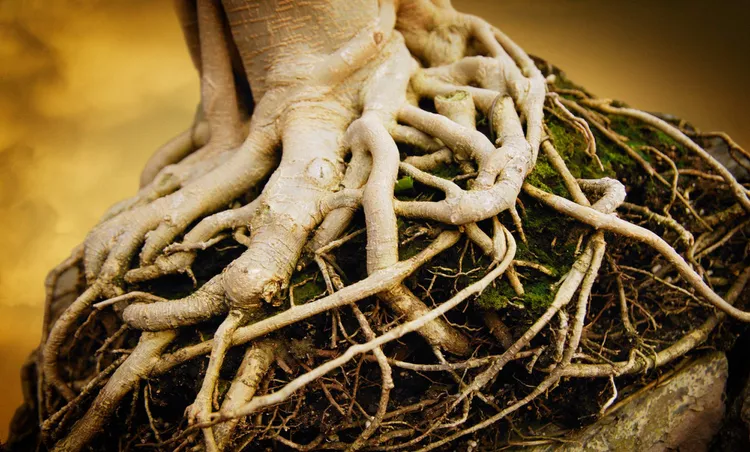Tree girdling almost always spells doom if not caught early and corrected. This common yet easily overlooked problem happens when something wraps so tightly around a tree (like a girdle) that it chokes off water and nutrients. A tree's own roots can often cause girdling if they begin circling the trunk. As the roots expand, they strangle the tree.
Too tight tree stakes and straps around the trunk or branches can girdle a tree. Girdling can also happen when the bark is damaged or removed around the trunk or a branch. Here's how to protect both newly planted trees and established trees from girdling, plus how to save a girdled tree.
What Causes Tree Girdling?
Lawn Care
Getting too close to the base of trees with your lawnmower or weedwhacker can damage enough bark to cause tree girdling. It's best to use a barrier around trunks or weed by hand around the base of your trees to protect the bark as much as possible.
Tree Roots
More commonly, tree girdling is caused by a tree's roots. Girdling roots often begin circling at the nursery when trees grow in a pot that is too small. The roots circle around the edge of the pot and turn back toward the center, eventually wrapping around the trunk and suffocating the tree. Balled-and-burlapped trees are less susceptible to girdling. Once young trees produce a girdling root pattern, the roots will continue growing in circles unless you take action to correct the problem (see tip #3 below).
Planting Errors
Poor planting is also a cause of tree girdling. Planting a tree too deeply or covering the root ball with too much mulch will send roots in circles. Heavy clay or compacted soil can also result in girdling roots. Leaving burlap, wire baskets, or twine around the trunk of a newly planted tree can cause tree girdling, too. Similarly, strapping used to secure the new tree to a stake can end up girdling the trunk or branches unless they're adjusted or removed as the tree grows. A proper staking strap should be loose enough for the tree to move an inch or two in the wind easily.
Tips for Preventing Tree Girdling When Planting
1. Plant at the proper depth.
The tree's root collar, the flare at the base of the trunk where roots extend, should be at or slightly above the surrounding soil line. When in doubt, planting the tree 1 or 2 inches too high rather than too deep is better.
2. Dig a wide planting hole.
Allow ample space for roots to expand outward by digging a wide planting hole. Backfill around the tree with the same garden soil you removed from the hole; don't add amendments or compost.
3. Inspect roots of container-grown trees and sever if needed.
Remove the tree from its container and look for roots beginning to circle the outer edge of the root ball. If you notice circling roots, use a utility knife to slice the roots from the top of the root ball to the bottom about 2 inches deep in 3 to 4 places. Cut roots regenerate quickly and will grow into the landscape soil.
4. Mulch lightly.
Cover the root ball with 2 inches or less of mulch. Don't let the mulch touch the root collar.
If you do need to stake a tree when planting, remove the stakes after six months, once the roots are stable, to prevent tree girdling.
How to Tell If Tree Girdling Is Due to Roots
When a tree begins to show signs of stress, such as developing fall color several weeks too early or stunted branch growth, definitely check the roots to see if they might be the cause. A healthy tree has roots that grow deep and outward from the trunk. If you see roots growing in a circular pattern around the base of the trunk instead, you'll need to correct the problem. If you don't see any roots, pull back the mulch or soil to expose them. Sometimes, girdling roots are buried under a too thick layer of mulch or soil.
Another indicator of a brewing problem is a tree trunk that enters the ground like a straight telephone pole. Remember that trees naturally flare out at the base of their trunk, and the root collar should be visible above ground. Girdling roots commonly occur when the tree is planted too deeply, and the root collar is buried.
How to Save a Girdled Tree
A tree with girdling roots tends to decline over a 5-to-10-year period. Red and sugar maples, along with American beech, pines, oaks, poplars, and elms, are most likely to develop tree girdling due to roots. However, depending on the situation, you may still be able to save a girdled tree.
Small roots encircling the trunk of an established tree can be removed with pruners or a sharp chisel and mallet. Remedying girdling roots 2 inches or more in diameter is best left to an arborist. Often, larger girdling roots are allowed to remain in place because there is no way to remove them without killing the tree faster than the root eventually will.
If a small or young tree has girdling roots because it was planted too deep, you may be able to replant it at the correct depth. Wait until fall or spring to disturb the tree, and make sure to dig up as much of its roots as possible. Cut any circling roots. Then, fill the hole with enough soil to hold the root collar at the correct depth and replant your tree. For a larger, more established tree that's planted too deeply, contact an arborist to help you solve the problem.




















